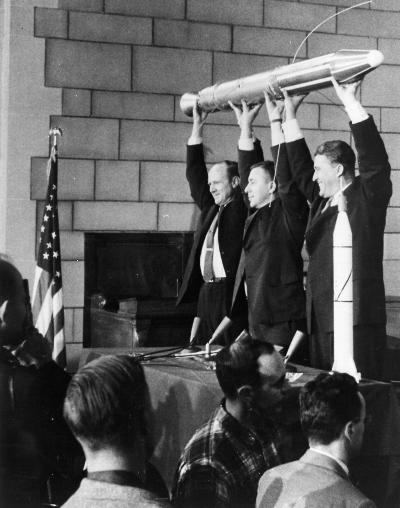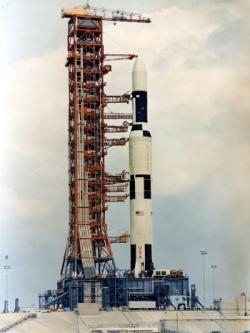Tested, Developed, And Recommended Vital Rocket Technologies
Engineers from the National Advisory Committee for Aeronautics (NACA), who joined NASA after its creation, tested, developed, and recommended one of the most vital technologies that the United States needed in order to successfully launch the Saturn rockets in the 1960s. These engineers had become experts in the field of high-energy propellants, particularly liquid hydrogen, and believed it should be used to power the upper stages of the Saturn rocket.

In 1959, these engineers made that critical recommendation to Wernher von Braun. The liquid hydrogen recommendation was not one that von Braun accepted at first. Von Braun and his team had more faith in the kerosene and liquid oxygen rocket propellants, with which they had more experience. He later acknowledged that the recommendation contributed immensely to NASA's successful attempt to land the first human beings on the surface of the Moon in 1969.
So how did the NACA get involved in rocket research?
The Cold War generated an emphasis on technological superiority. That quest tested America’s capacity for innovation and change. Around the same time, the development of the jet engine lessened the need for extensive research on fuels associated with traditional aircraft. Lewis Laboratory (now Glenn Research Center) Director Abe Silverstein drew new organizational charts, the first to openly acknowledge that the NACA and the Lewis Laboratory were ready to pursue research in rocketry.
Once again, however, the NACA faced a new boundary. Cold War politics compelled the agency to ensure that the innovations its labs generated were geared toward improvements in missile defense. Congress and the Eisenhower Administration referred to these improvements as a top national priority. However, some within the NACA wanted to rein in NACA’s rocket work. They feared a Congressional backlash if the agency stepped too far outside its charter.
When, in 1957, the Soviets launched Sputnik, the world’s first man-made satellite, the NACA’s work on high-energy propellants rose to a new level of importance. By this time, the NACA included a staff or 8,000 people, $300 million in facilities, and 27 committees and 24 subcommittees.
On November 22, 1957, Lewis Laboratory operated the first hydrogen-fluorine rocket engine. The test demonstrated a 40-percent improvement over other propellant combinations. That same year Lewis conducted the first operation of a 20,000 pound thrust liquid-hydrogen-oxygen engine completely self-cooled by liquid hydrogen.
In January 1958, the U.S. Army team in Huntsville led by von Braun designed the launch vehicle for Explorer I, America’s first satellite. Driven to become technologically superior to its Cold War rival, plans were afoot to vest the authority for non-military aeronautics and space exploration in a single civilian agency. In October 1958, NASA incorporated the former NACA team as its nucleus for aviation and aeronautics.
In addition, 4,000 Army civilians led by von Braun eventually joined NASA in 1960 to form the George C. Marshall Space Flight Center in Huntsville a transfer not completed for two years after NASA’s creation. Von Braun and his team waited for the transfer decision while they officially continued to work on Saturn under a NASA agreement with the Army.
Silverstein and NACA leaders like NACA Director Hugh Dryden had already joined the discussions in late 1957 and early 1958 about how to constitute the new space agency. In May 1958, Silverstein transferred to NACA Headquarters in Washington to help plan the organization and programs of NASA, subsequently becoming Director of NASA's Office of Space Flight Programs in October 1958. Dryden served as Director of NACA from 1947 until the formation of NASA, when he became NASA Deputy Administrator. One of the top decisions that NASA faced involved selection of the upper stages of the Saturn V rocket. Silverstein chaired a committee that included representatives from the Advanced Research Projects Agency (ARPA), the Air Force, NASA, the Army Ballistic Missile Agency in Huntsville, and the Department of Defense.

Silverstein recalled the committee's work at an event marking NASA's Twentieth Anniversary in 1980. Silverstein said that engineers at Lewis had calculated that a decision to use conventionally fueled upper stages on the Saturn V would require NASA to use first stages that were more than twice as large than would be required if hydrogen oxygen stages were used in the upper stages.
"The army team were apparently willing to take on the difficulties associated with building a booster big enough using kerosene and liquid rather than the hazards which they contemplated in the use of hydrogenous fuel." Silverstein recalled.
Silverstein added that the NACA had pioneered in the use of hydrogenous oxygen and had operated small rocket engines with hydrogenous fuel for ten years prior to the decision time on Saturn and was well accustomed to its use and its safety. "It was our feeling that hydrogen...was just as safe as kerosene." he recollected.
On the morning of the last day of scheduled meetings, von Braun entered the meeting and finally agreed with Silverstein. "What lead him to this final decision I’ll never know, but it was certainly the correct one," Silverstein recalled.
In years to come, both the liquid hydrogen powered J-2 and RL-10 engines served as vital contributions to the success the Saturn-Apollo Program that took the first Americans to the Moon in 1969, thanks to the hard work that engineers from the NACA, Army, and NASA engineers devoted to the Saturn/Apollo Program.
(Image provided by NASA)
 ANN's Daily Aero-Linx (04.15.24)
ANN's Daily Aero-Linx (04.15.24) Classic Aero-TV: 'No Other Options' -- The Israeli Air Force's Danny Shapira
Classic Aero-TV: 'No Other Options' -- The Israeli Air Force's Danny Shapira Aero-News: Quote of the Day (04.15.24)
Aero-News: Quote of the Day (04.15.24) Airborne 04.16.24: RV Update, Affordable Flying Expo, Diamond Lil
Airborne 04.16.24: RV Update, Affordable Flying Expo, Diamond Lil ANN's Daily Aero-Term (04.16.24): Chart Supplement US
ANN's Daily Aero-Term (04.16.24): Chart Supplement US




